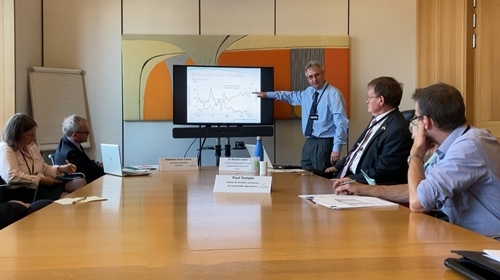
The GWCT runs an All-Party parliamentary discussion group (APPG) on Game & Wildlife Conservation (you can find out more about its history and the topics we’ve discussed here). Our most recent meeting debated how we can reconcile the seemingly conflicting objectives of food production and the environment, when the amount of land to feed each one of us on this planet has dropped from 2 acres to less than half an acre in the last 50-60 years. The challenge is how to approach this conundrum; many would argue for a land-sharing approach whilst others feel land-sparing is better. However, underlying this is also how we manage (or not) the land.
We invited our speakers [1] to put forward their view of where in the food production-rewilding continuum the answer lies. The outcome was surprisingly reassuring, demonstrating that consensus is possible and that there is room for all approaches to work together if appropriately targeted.
Farmer Paul Temple demonstrated how he is making his food production system “greener” through adopting direct drilling and introducing grass into his rotation. His environmental wins are encouraging; more worms, beetles, soil bacteria and small mammals across his farmed land – not just on the wildlife areas.
This complemented the approach at the Allerton project described by Dr Alastair Leake of focussing production ‘in-field’ and re-purposing the less productive margins and unproductive land for environmental outcomes. The underlying principle behind both in-field and margin is the need for management. It is not simply enough to focus this on the commercial crop.
Work at Allerton has demonstrated that by applying some nitrogen to seed-bearing crops (combined with attention to detail at establishment) more seed is produced, benefitting more birds. It is not surprising therefore that the GWCT was able to demonstrate a doubling of songbird numbers at Allerton whilst maintaining yields when the national picture remains one of continuing decline. Our managed approach has also supported higher numbers of Brown Hares and moths than surrounding areas.
But what of rewilding? Dr Steve Carver’s presentation was insightful not least because it demonstrated that the term rewilding has become a hindrance to open-minded debate and that a more constructive approach is to view ‘core’ rewilding (nature enabled, human led but with reduced intervention over time) as accounting for 5% of our land area with a further 25% focussed on regenerative agriculture and other agro-ecological approaches (human-led, nature enabled). It is in this 25% that Farmer Clusters could provide the necessary geographical connectivity – so neatly espoused by the Lawton Review as “Bigger, Better, More and Joined”.
Consequently, instead of focussing policy on the land sharing v land sparing continuum, a three-compartment model is more relevant comprising semi-natural habitats, with high-yield farming and low-yield farming incorporating managed habitat. These ‘compartments’ reflect the three speakers and emphasise that the outcomes that we all seek (food security, nature recovery and other environmental gains) are possible from our countryside – you just need the right people in the right place at the right time to come up with the right answers. And at our APPG we achieved just that!
[1] Our speakers were: Paul Temple a farmer and member of the Science for Sustainable Agriculture, Dr Steve Carver from the IUCN CEM Task Force on Rewilding and Dr Alastair Leake from the Game & Wildlife Conservation Trust’s Allerton Project